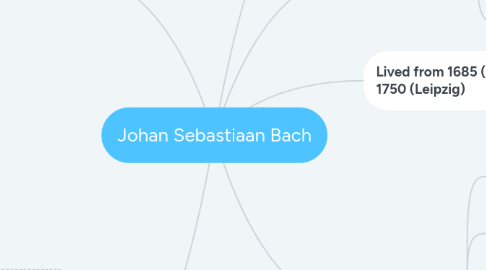
1. Composed music during the Baroque (together with Rameau and Monteverdi considered the best musician of his time).
2. Childhood
2.1. Born March 21 in Eisenach as the youngest of 8 children
2.1.1. Raised a Lutheran Christian, and was taught that playing music was a God given divine gift, not a 'human skill'
2.2. Taught violin by his father, in whose house musicians from Eisenach gathered to play
2.2.1. Parents died in 1694 and 1695, so Bach was an orphan at the age of 9 and moved in with his older brother Johann Christoph, who saw Bach's talent and helped him play the organ and klavier (keyboard)
2.2.1.1. Moved to boarding school in Luneburg (North Germany) at 15, where he began writing his own organ compositions
3. Lived from 1685 (Eisenach) to 1750 (Leipzig)
4. Adult life
4.1. Known to have a fiery temper and every now and then enjoy large quantities of alcohol
4.2. Two marriages, 17 kids
4.2.1. 1707: Married to Maria Barbara Bach, with whom he had 7 kids. She died in 1720.
4.2.2. 1721: Married to Anna Magdalena, with whom he had 20 kids, of which 10 died.
4.3. Court Organist and Konzertmeister in Weimar for duke Johan Ernst III (1664-1707 / 1714)
4.4. Kapelmeister for Prince Leopold von Anhalt-Kolten 1694-1728
4.4.1. Culture shock! Leopold was Calvinist, not Lutheran, so Bach had to change his music.. and his attitude.
4.4.1.1. Music changed from being majorly for religious purpose, to non-religious music for concerts, parties and special occasions such as celebrations.
4.5. Most productive fase of Bach: Leipzig 1723
4.5.1. Was cantor and had the musical leadership over three major churches. Leipzig was the cultural musical epicenter of protestant Germany
4.5.1.1. Stayed in Leipzig untill his death in 1750
4.5.1.1.1. After his death, his music was forgotten and not revived until 1829.
4.5.2. Wrote over 100 cantates, performed for the Prussian king Frederik II.
5. Music
5.1. Musical inspiration
5.1.1. The rhythms and harmonious music schemes of Antonio Lucio Vivaldi and Arcangelo Corelli
5.2. Famous pieces
5.2.1. Matthäus-Passion, 1727.
5.2.1.1. Chapter 26 and 27 of the Matthaus gospel. Describe Christ's crucifixion. Piece lasts 2,5 / 3 hours
5.2.2. Johannes Passion
5.2.3. Wir danken Dir, Gott, wir danken Dir, 1731.
5.2.3.1. Written to celebrate the installation of a new city council.
5.2.4. Wohltemperierte Klavier
5.2.5. Jesu meine Freunde
5.2.6. Minuet in G (BMV 114) (Paddenstoelen muziekje Efteling)
5.2.7. Toccata and Fugue in D minor
5.3. Musical characteristics
5.3.1. combined melody, harmony, rhythm with dance
5.3.2. Contrapoint
5.3.3. Fuga
5.3.3.1. Using meerstemmigheid and repetition are key features of the music piece
5.3.4. Cantates
5.3.4.1. Musical compositions for one or more singers, accompanied by instruments (20/40 minutes)
5.3.5. Using the passion of Christ (lijdensverhaal) as the core theme of his music
6. Bach's Air on G string
6.1. Why is it Baroque?
6.1.1. Instrumenten
6.1.1.1. Predominantly strings
6.1.1.1.1. Orchestral collection of instruments: strings, winds and harpsichord with very little percussion
6.1.2. Vorm
6.1.2.1. Bach's Air on G string projects a single singel mood or expression of feeling, which is very common to Baroque pieces.
6.1.3. Stijlkenmerken
6.1.3.1. Abrupt shifts from loud to soft, achieved by adding or subtracting instruments.
6.1.3.2. There is a quite some repetiton of melodies, which is also common to Baroque music.
6.1.4. Melodie
6.1.4.1. Vibrant rhythms and expressive dissonances to heighten tension
6.1.4.1.1. Continuous rhythmic drive
6.1.5. Harmonie
6.1.5.1. Complex polyphonic structures
